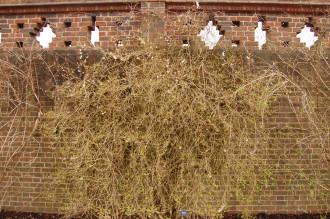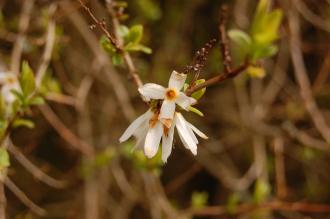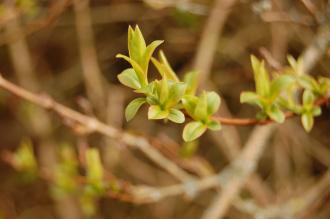
Abeliophyllum distichum Wall Trained Shrub (29/03/2015, Kew Gardens, London)
Position: Full sun
Flowering period: Late winter to early spring
Soil: Moist, well drained
Eventual Height: 1.5m (Taller when against a wall)
Eventual Spread: 2.5m
Hardiness: 5b, 6a, 6b, 7a, 7b, 8a, 8b, 9a
Family: Oleaceae
Abeliophyllum distichum is a deciduous shrub with a bushy, scrambling habit. Its dark green leaves are up to 10cm long and 4.5cm across. Its fragrant white/ pale pink flowers are composed of four petals, are up to 1cm across and appear just before its leaves emerge. Its fruit is a winged sumara.

Abeliophyllum distichum Flower (29/03/2015, Kew Gardens, London)
Abeliophyllum distichum, commonly known as White Forsythia or Korean Abelialeaf, is native to central Korea. It is the only plant within this genus and is close to extinction in its native habitat.
The etymological root of the binomial name Abeliophyllum is derived from Abelia (another genus of shrub) and the Greek phyllon meaning ‘leaf. Distichum is derived from the Greek distichos meaning ‘two ranked’.
The landscape architect may find Abeliophyllum distichum useful as a wall trained shrub. It prefers a sheltered location as it flower are damaged by late frosts.

Abeliophyllum distichum Emerging Leaf (29/03/2015, Kew Gardens, London)
Ecologically, Abeliophyllum distichum flowers are attractive to pollinating insects.
Abeliophyllum distichum prefers moist, fertile, well-drained soils. It tolerates most pH of soil. It dislikes dry soils.
Abeliophyllum distichum requires pruning after flowering, this will encourages the following years flowers.

